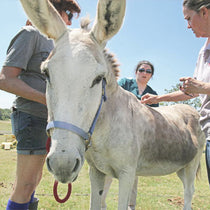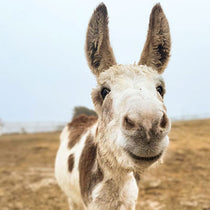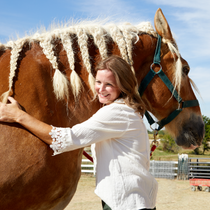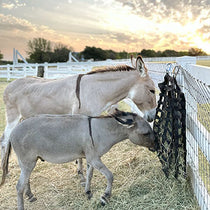5 Months out of Starvation

Turning the Corner
We never know how or why animals are starved. Sometimes, owners are taken to court and animals become forced surrenders. Other times, like Mae, we just find them barely hanging on at a sale lot / killpen where last-chance animals are showcased before they're loaded for slaughter. Starvation like Mae's is a tragedy -- it's a slow, painful death that no one should have to experience.

She arrived grade 1 just 5 months ago, barely able to stand, walk or chew, and completely unable to move her ears, lift her tail, regulate her body temperature or lift her head from a drooped position. Read details about her arrival HERE.
Mae had a lot of trouble eating, which is normal for a starved horse. She could barely move her jaw. We provided strict refeeding meals 6 times a day which included "soup" that was easy to slurp down -- a senior alfalfa feed, mixed with probiotics & gallons of hot water, and topped with alfalfa leaves (we stripped and shook every flake of hay to create a mound of loose leaves).
After several months, Mae gained enough strength to walk and roll. She was finally clear of the pneumonia and fluid on the lungs that she came in with. We began to let her into the field with one horse at a time.
We thought everything was fine. She would graze along side them. At lunch time, when she came into her stall, she'd drop a baseball-sized wad of grass onto the ground. The poor thing was trying so hard to fit in, she was fake-grazing. But she couldn't swallow the grass. It would just churn around in her mouth until we brought her into her private stall. Then she'd spit it out before eating her soup.
What's Going On in Her Mouth?
Dr. Metcalf had to wait until she survived her starvation refeeding program to actually do a full dental workup on Mae because in her frail state, any major poking and prodding can be fatal. When he was finally able to peek inside, we were all shocked.

1. Mae is easily over 30 years old. Where previously, it was thought her age was mid to late 20's, Mae is actually the oldest animal at our Sanctuary.
2. She barely has teeth. 3 on each upper side, and they're rotten. Her lower jaw is essentially toothless.
Dr. Metcalf described horse's chewing like a conveyor belt. The teeth grind and move hay and grass from the front to the back, and down the throat. Since Mae's teeth are inoperable, she was unable to swallow the hay or grass at the front.
We won't know if this is how Mae starved. She was in terrible, unkempt shape -- hooves overgrown, infected skin, pneumonia and fluid on the lung, cuts on her back. If an owner leaves a horse in a field, assuming they'll forage from the pasture, a horse will starve if it has tooth problems or is lacking teeth. This is in no way an excuse for why an owner would see a horse dwindling to nothing, and do nothing for them. But it is very likely a contributing factor to her condition.
Soup & Overnight Stays

While all our Sanctuary animals live in a big community -- with access to all the many barns, gazebos and stalls 24 hours a day -- Mae is a special case. Horses cannot go more than 4 hours without food. They are foragers, and their bodies turn on themselves if they don't have food in their stomach. Mae will chew grass and hay from the hay bags, but she can't swallow it.
So around 3 pm in the afternoon each day, we deliver a large bowl of her soup for the night, and she gets to enjoy her own stall and paddock with all you can eat service till morning. She doesn't love it. We see her stand in her patio, feeling better than she's ever felt in her life, wanting to go be with her friends in the field. Sometimes we bring visitors. But we want her to live as many of the oldest years of her life as possible, so we've resolved that she'll get soup and overnight stays.

One Last Trip Up
Each morning when we would let Mae out to the field, she would be so excited to run to the pasture with her friends that she would trip. It happened twice, and the second time she cut open her armpit and needed stitches. Another visit from Dr. Metcalf to examine her wound, and we mentioned she'd tripped twice. He immediately suspected a neurological problem - performed a neurological test and found yes, he suspects she came to us with EPM -- a disease equines catch from possums. She's half way through receiving medicine to treat this disease, and she's already looking even more plump and walking & trotting without stumbling!

Thank you from hoof to teeth!
All of these life revelations are only made possible with the best vet care and financial support provided through the products you purchase and love everyday! From Mae's teeth to her hooves, we are so grateful to you all for making her healing possible. Mae's a hugger. She'll follow every guest who comes to the ranch, walking lock step as you make your way across the pasture, just hoping for scratches and hugs. Here's hugs to you all!











